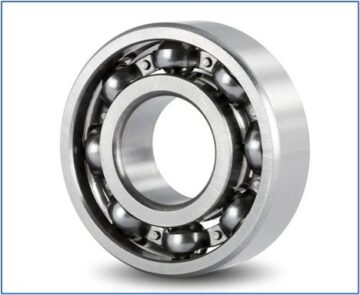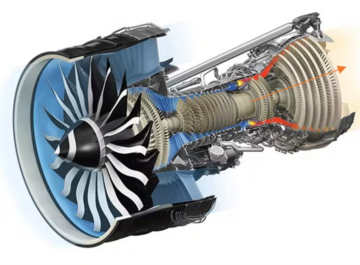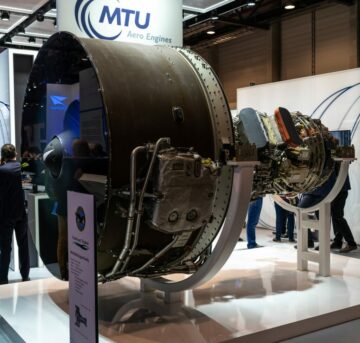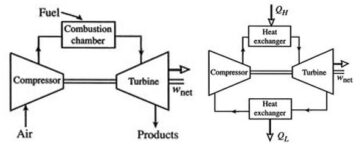A review of the literature on mixed-flow turbomachinery reveals a surprising variation in the ways engineers use the term ‘mixed-flow turbomachine’. In particular, two main conceptions of the term stand out. On the first conception, ‘mixed-flow’ refers to the union of axial and radial flow directions into one diagonal flow, resulting in what some call diagonal turbomachines. In the second conception, ‘mixed-flow’ refers to the combination of distinct elements where the flow is axial in some and radial in others. This kind of machine is sometimes called an axial-radial combined turbomachine.
Diagonal turbomachines utilize a flow angle that is between axial and radial and may be considered mere variants of radial machines. The diagonal flow angle allows these machines to enjoy some benefits from both axial and radial flows. In contrast, axial-radial combined turbomachines represent a strategic integration of both axial and centrifugal designs.
In light of the ambiguous use of the term, one might reasonably wonder what truly defines a mixed-flow turbomachine. Is it the convergence of flow directions, the strategic blending of different machine types, or a fusion of design elements?
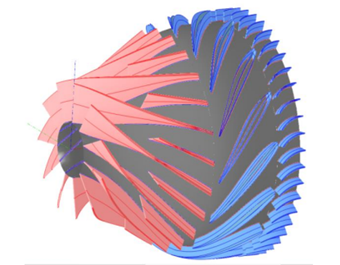
Diagonal turbomachines are characterized by their flow’s meridional exit angle, which ranges between 0 and 90 degrees. This geometry enables the flow to exit closer to an axial direction, with the exit mean radius greater than that of the inlet. In mixed-flow compressors, this design facilitates higher efficiencies within a constrained cross-sectional area. This advantageous setup addresses a critical need in various applications like unmanned aerial vehicles (UAVs), where the integration of gas turbines demands superior performance within limited spatial constraints as well as a high thrust-to-weight ratio.
Meanwhile, in mixed-flow turbines, the amalgamation of radial and axial turbine elements carries its own benefits. By minimizing flow path curvature and reducing secondary flow, axial-radial combined turbines can optimize performance. This hybrid design incorporates a variable cone angle at the blade inlet, facilitating a nonzero blade angle while maintaining radial integrity. The forward sweep at the inlet not only enhances performance but also ensures structural stability—a crucial factor in turbine efficiency and reliability. Compared to radial turbines, axial-radial combined turbines possess an inherent flexibility in design and operation, positioning them as an ideal choice in various industrial applications where efficiency, adaptability, and reliability are paramount.

This combination is notably employed in gas turbine engines, where the integration of axial and centrifugal compressors plays a pivotal role in enhancing overall efficiency and performance. The combination involves positioning the axial-flow compressor as the low-pressure compressor at the front, while the centrifugal-flow compressor assumes the role of the high-pressure compressor at the rear.

The placement of centrifugal compressors in the final stage leverages the reduced volume of gas or air at that stage, allowing for a smaller compressor size and mitigation of challenges associated with larger frontal areas. Additionally, the wide operational range of mass flow rates without stalling makes centrifugal compressors adept at handling the reduced volume encountered in the final compression stages.
By contrast, radial-axial combined turbines employ the reverse arrangement to axial-centrifugal compressors. In these turbines, flow enters the radial part first, leveraging the variable range capacity of radial turbines. The flow is then directed into the axial part after expansion, taking advantage of the high flow rate capacity inherent to axial turbines. This arrangement optimizes the utilization of both radial and axial turbine capabilities, allowing for efficient energy extraction and utilization across a wide spectrum of flow conditions.

To summarize, the categorization of both diagonal and axial-radial combined turbomachines under the umbrella term ‘mixed flow turbomachine’ holds significant merit. In the case of diagonal turbomachines, the term ‘mix’ directly reflects the flow characteristics, which lie between the purely axial and radial directions. This intermediate flow path embodies the essence of mixing two distinct flow patterns, leading to the efficient utilization of both axial and radial flow advantages.
Similarly, with axial-radial combined turbomachines, the term “mixed flow” resonates with the integration of axial and radial machinery. The combined geometry allows engineers to capitalize on the strengths of both axial and centrifugal compressors in gas turbine engines, thereby achieving optimized performance and efficiency. The term “mix” here underscores the strategic combination of these two distinct machine types, enabling the utilization of their individual advantages within a unified, synergistic system.
In light of these considerations, we’d like to pose a question: What do mixed-flow turbomachines signify to you? Are they indicative of the convergence of flow directions, the amalgamation of different machine types, or perhaps a subtle blending of various design and operational elements? Your insights are appreciated, and we look forward to reading your comments!
References:
[1] https://www.softinway.com/wp-content/uploads/2020/09/Flow-Studies-in-a-Mixed-Flow-Compressor-Stage.pdf
[2] Rajakumar, D. & Ramamurthy, Surender & Govardhan, Mukka. (2014). Experimental investigations on effects of tip clearance in mixed-flow compressor performance: https://doi.org/10.1177/0954410014541102
[3] https://aviation_dictionary.en-academic.com/786/axial-centrifugal_compressor
- SEO Powered Content & PR Distribution. Get Amplified Today.
- PlatoData.Network Vertical Generative Ai. Empower Yourself. Access Here.
- PlatoAiStream. Web3 Intelligence. Knowledge Amplified. Access Here.
- PlatoESG. Carbon, CleanTech, Energy, Environment, Solar, Waste Management. Access Here.
- PlatoHealth. Biotech and Clinical Trials Intelligence. Access Here.
- Source: https://blog.softinway.com/what-exactly-is-a-mixed-flow-turbomachine/
- :is
- :not
- :where
- 1
- 175
- 2%
- 2014
- 3d
- 3D view
- 4
- 90
- a
- achieving
- across
- adaptability
- Additionally
- addresses
- adept
- adopted
- ADvantage
- advantageous
- advantages
- After
- AIR
- Allowing
- allows
- also
- an
- and
- angle
- applications
- appreciated
- ARE
- AREA
- areas
- arrangement
- AS
- associated
- assumes
- At
- b
- BE
- benefits
- between
- BLADE
- blending
- both
- but
- by
- call
- called
- CAN
- capabilities
- Capacity
- capitalize
- case
- challenges
- characteristics
- characterized
- choice
- clearance
- closer
- combination
- combined
- compared
- conception
- conditions
- considerations
- considered
- constrained
- constraints
- contrast
- Convergence
- critical
- crucial
- Defines
- demands
- Design
- designs
- different
- directed
- direction
- directions
- directly
- distinct
- do
- effects
- efficiencies
- efficiency
- efficient
- elements
- embodies
- employed
- enables
- enabling
- energy
- Engineers
- Engines
- Enhances
- enhancing
- enjoy
- ensures
- Enters
- essence
- Ether (ETH)
- exactly
- Exit
- expansion
- experimental
- extraction
- facilitates
- facilitating
- factor
- Figure
- final
- First
- Flexibility
- flow
- Flows
- For
- Forward
- from
- front
- fusion
- GAS
- geometry
- gif
- greater
- Handling
- here
- High
- higher
- holds
- HTTPS
- Hybrid
- ideal
- in
- incorporates
- indicative
- individual
- industrial
- inherent
- insights
- integration
- integrity
- Intermediate
- into
- Investigations
- involves
- IT
- ITS
- Kind
- larger
- leading
- leverages
- leveraging
- lie
- light
- like
- Limited
- literature
- Look
- machine
- machinery
- Machines
- Main
- maintaining
- MAKES
- Mass
- max-width
- May..
- mean
- mere
- Merit
- might
- minimizing
- mitigation
- Mixing
- Need
- nonzero
- notably
- of
- on
- ONE
- only
- operation
- operational
- Optimize
- optimized
- Optimizes
- or
- Others
- out
- overall
- own
- Paramount
- part
- particular
- path
- patterns
- performance
- perhaps
- Photos
- pivotal
- placement
- plato
- Plato Data Intelligence
- PlatoData
- plays
- pose
- positioning
- possess
- purely
- question
- range
- ranges
- Rate
- Rates
- ratio
- Reading
- Reduced
- reducing
- refers
- reflects
- reliability
- represent
- resonates
- resulting
- Reveals
- reverse
- review
- Role
- Second
- secondary
- setup
- significant
- signify
- Size
- smaller
- some
- sometimes
- Spatial
- Spectrum
- Stage
- stages
- stalling
- stand
- Strategic
- Strategic Integration
- strengths
- structural
- subtle
- summarize
- superior
- surprising
- Sweep
- synergistic
- system
- taking
- term
- than
- that
- The
- their
- Them
- then
- thereby
- These
- they
- this
- tip
- to
- truly
- turbine
- two
- types
- umbrella
- under
- underscores
- unified
- union
- use
- utilization
- utilize
- variable
- variants
- various
- View
- volume
- ways
- we
- WELL
- What
- which
- while
- wide
- with
- within
- without
- wonder
- you
- Your
- zephyrnet

